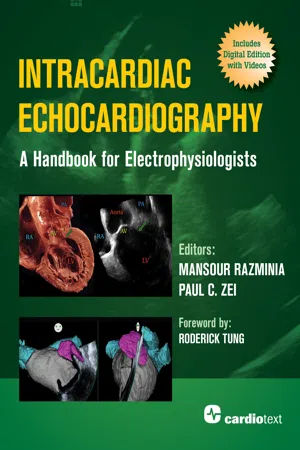
Intracardiac Echocardiography: A Handbook for Electrophysiologists
- English
- ePUB (mobile friendly)
- Available on iOS & Android
Intracardiac Echocardiography: A Handbook for Electrophysiologists
About this book
A focus on intracardiac echocardiography (ICE), with an emphasis on practical use during electrophysiological procedures. This illustrated text, complemented by more than 50 instructional videos, presents description, rationale, and instruction in ICE utilization for the complete range of currently performed EP procedures, including mapping and ablation procedures, device implantation procedures, and all common variations on these procedures. ICE is the only continuous real-time imaging modality with widespread utilization by electrophysiologists:
- Reliably and accurately visualize intracardiac and extracardiac structures and placement of catheters within the heart chambers.
- Observe anatomic detail otherwise invisible.
- Potentially improve procedural safety and efficacy.
This text is written and edited by experts with extensive experience and knowledge that they have imparted to the reader. The editors have previously collaborated on a related textbook from Cardiotext Publishing, Fluoroscopy Reduction Techniques for Catheter Ablation of Cardiac Arrhythmias. All it took was one visit from Mansour Razminia to UChicago during a patient collaboration to provide step-by-step guidance to not only perform fluoroless transseptal puncture, but to quickly and beautifully visualize every anatomic region with simple and reproducible clock/counter/flex/ bend commands. It changed my life. ?From the Foreword, Roderick Tung, MD Editors:
- Mansour Razminia, MD; Amita St. Joseph Hospital, Elgin, Illinois
- Paul C. Zei, MD, PhD; Brigham and Women's Hospital, Boston, Massachusetts
This book includes access to a library of 53 videos. The purchase of a new copy of this print book entitles the first buyer to free personal access to a digital version of this edition. Redemption instructions are included in the book.
Frequently asked questions
- Essential is ideal for learners and professionals who enjoy exploring a wide range of subjects. Access the Essential Library with 800,000+ trusted titles and best-sellers across business, personal growth, and the humanities. Includes unlimited reading time and Standard Read Aloud voice.
- Complete: Perfect for advanced learners and researchers needing full, unrestricted access. Unlock 1.4M+ books across hundreds of subjects, including academic and specialized titles. The Complete Plan also includes advanced features like Premium Read Aloud and Research Assistant.
Please note we cannot support devices running on iOS 13 and Android 7 or earlier. Learn more about using the app.
Information
Introduction
Basics of Ultrasound

Acoustic Impedance
Reflection
Refraction
Scattering
Attenuation

Imaging Techniques Used in ICE
2D Echo
3D Echo
Doppler Echocardiography
Continuous Wave Doppler
Pulsed Wave Doppler
Color Flow Doppler
Types of Intracardiac Echocardiography Systems

Table of contents
- Cover
- Title
- Copyright
- Dedication
- Table of Contents
- Contributors
- Foreword
- Preface
- Abbreviations
- Video Legends
- 1 Basic Principles of Intracardiac Echocardiography
- 2 Cardiac Anatomy
- 3 How to Manipulate ICE: From Basic to Advanced
- 4 How to Use ICE for Transseptal Puncture
- 5 How to Use ICE for Catheter Ablation of Right Atrial Tachycardia/Flutter
- 6 How to Use ICE for Catheter Ablation of Supraventricular Tachycardia
- 7 How to Use ICE to Monitor the Esophagus
- 8 How to Use ICE for Radiofrequency Catheter Ablation of Atrial Fibrillation and Left Atrial Arrhythmias
- 9 How to Use ICE for Cryoballoon Ablation of Atrial Fibrillation
- 10 How to Use ICE for Catheter Ablation of Right Ventricular and Right Ventricular Outflow Tract Arrhythmias
- 11 How to Use ICE for Catheter Ablation of Papillary Muscle PVC
- 12 How to Use ICE for Catheter Ablation of Left Ventricular Outflow Tract, Coronary Cusps, and the LV Summit PVC
- 13 How to Use ICE for Ischemic VT Ablation
- 14 How to Use CARTOSOUND During Catheter Ablation of Cardiac Arrhythmias
- 15 How to Use ICE in Patients with Congenital Heart Disease
- 16 How to Use ICE to See Abnormal Anatomy and for Early Diagnosis of Procedural Complications
- 17 How to Use ICE for LAA Closure Device Placement
- 18 How to Use ICE for Lead Extraction
- 19 How to Use ICE for Catheter Ablation in the Intrapericardial Space
- 20 Future Directions of Intracardiac Echocardiography (ICE)
- Author Disclosures
- Index